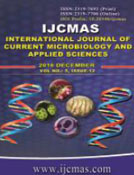


 National Academy of Agricultural Sciences (NAAS)
National Academy of Agricultural Sciences (NAAS)

|
PRINT ISSN : 2319-7692
Online ISSN : 2319-7706 Issues : 12 per year Publisher : Excellent Publishers Email : editorijcmas@gmail.com / submit@ijcmas.com Editor-in-chief: Dr.M.Prakash Index Copernicus ICV 2018: 95.39 NAAS RATING 2020: 5.38 |
Cervical lymphadenitis is one of the common modes of presentation in extra pulmonary tuberculosis. It is easy to suspect and establish the diagnosis but a difficult course to follow. It is even more perplexing to establish resolution of infection or document drug resistance. The limiting factor remains frequent FNAC, while in pulmonary tuberculosis sputum collection and its analysis is easy and non invasive. This prospective study was undertaken on OPD basis in division of Infectious Diseases, Department of Medicine, SKIMS, Kashmir. 32 patients of FNAC/ Biopsy proven isolated cervical tuberculosis were included in this study. The mean age of presentation was 24.6+_13.4 years. 12 patients were males and 20 patients were females. The common presentation was neck mass (100%), fever (64%), night sweats (12%), cough (3%), Ill health (3%). Diagnosis was established by FNAC and nodal biopsy were ever necessary. In 8(33%) patients who were retreatment cases nodal material was sent for molecular diagnosis to establish resistance. CBNAAT, line probe assay analysis revealed INH resistance in 3 patients(9.3%), RMP resistance in 2 patients(6.1%) and 3 patients(9.3%) were sensitive to both INH and RMP. No documentation of MDRTB was done. 1 patient was HIV positive amongst 12 patients tested for retrovirus in relevant clinical context. All patients were treated with standard regime on daily basis. Patients with resistance were treated as per standard drug regime. Cervical tubercular lymphadenopathy is separate disease from pulmonary tuberculosis in terms of diagnostic difficulty, paradoxical reactions, evaluation of clinical course, documentation of cure and resistance. This study emphasizes that tubercular lymphadenitis occurs in young patients with female preponderance. The study advocated routine nodal sampling for molecular diagnostics in relevant clinical context. The study wanted to highlight the limitation of repeated aspirations to establish cure or resistance.
 |
 |
 |
 |
 |